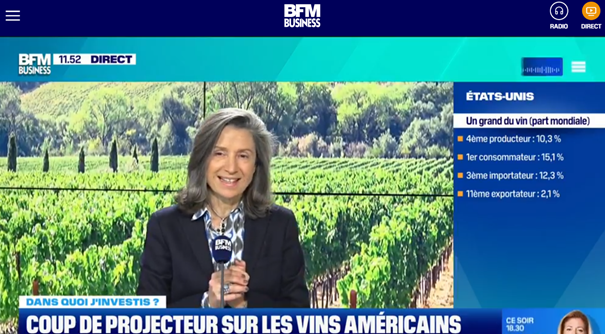
This interview does not cover about what you think it might. We’re here to celebrate American wine and how it performs at auction. It is home to fine wine that has gain global interest from wine lovers and producers alike. But how much space should they take up in a collection? That is what Lorraine Goumot wanted to find out when she interviewed Angélique de Lencquesaing on the French news channel BFM last week.
American wines come from the “New World” as the age-old expression goes?
The New World isn’t that new in reality. This name is used to describe vineyards that are at least 400 years old, making them not so new. It basically refers to any wine-making region that is outside of Europe. As is often the case elsewhere, growing vines in these areas had strong ties to religion in the past. In some countries christened the New World, the vine was brought over by those from Europe who colonised the land, while in others, other vine species were already growing. In the 18th century, Spanish missionaries planted the first European vines in California to produce wine for Mass. European vines then spread around the region, supported by none other than Thomas Jefferson, who was the American Minister to France from 1785 to 1789, living in Paris during this time.
Is it true that the USA saved French vineyards when phylloxera hit?
Yes! When phylloxera hit French vineyards in the 1870s (as well as the rest of Europe), the roots of American vines were grafted onto the European Vitis Vinifera as the American roots were resistant to the insect, allowing European vineyards to be replanted. American thirst for wine diminished during Prohibition in the 1920s but refound its stride in the 1960s when a few visionary figures such as Robert Mondavi flourished.

The vineyards on the West Coast in Napa Valley in California are the most famous?
Yes, and Robert Mondavi was one of the famous names in the region. Many wine enthusiasts know him as the winemaker who created Opus One with Baron Philippe de Rothschild (owner of Château Mouton Rothschild in Pauillac). 90% of American wineries are located in California. While Napa Valley, located inland (about 160km from the ocean), is known for its warm climates, other regions such as Sonoma Valley benefit from ocean breezes. Russian River Valley is also known for its cooler climate.
And famous European varieties reign here?
Yes, California is the kingdom of Cabernet Sauvignon, while Sonoma Valley being cooler is more suited to Chardonnay, Pinot Noir and Merlot.
In the south of the Central Coast region, Rhône varieties such as Syrah can be found. The West Coast also produces wines from Riesling and Gewürztraminer as well as Zinfandel, which goes by the name Primitivo in Italy.
Are there other American regions to discover?
Yes, absolutely! Oregon is certainly one to dive into. It’s a smaller region (its size is similar to that of Beaujolais, around 10,000 hectares) and its cooler climate makes it perfect for growing Pinot Noir. On that note, some of Burgundy’s producers have explored the region and the Drouhin family invested in land in Williamette Valley at the end of the 1980s and more recently, Jean-Nicolas Méo of Domaine Méo-Camuzet has joined forces with music producer Jay Boberg to create Domaine Nicolas & Jay. Even further north, there’s Washington State, where you can also find Pinot Noir along with Merlot and Riesling. On the East Coast, vines also grow in the north of New York State with the most famous region being Finger Lakes.
Where do American vineyards fit in with the rest of the wine world?
American vines cover quite a small amount of space compared to the size of the country. There are 392,000 hectares which is equivalent to 0.04% of the country’s land. Nevertheless, The USA is the fourth largest wine producer in the world after Italy, France and Spain.
In terms of consumption, Americans drink on average 11.8 litres of wine per year per adult inhabitant. In 2023, the country consumed 33.3 million hectolitres, making it the largest consumer of wine in the world. So it’s a strategic market not only for wines produced on its land but also for imported wine.
Are American wines exported, and can they be found in collections in the rest of the world?
For the most part, American wines stay in the USA. Less than 15% of its production is exported. However, the country doesn’t produce enough wine to satisfy its demand, so they import about a third of the wine it consumes. So what we can see on the secondary market, and at iDealwine in particular, is that very few American wines appear at auction.
What is interesting with iDealwine auctions is that the collections mainly come from France, Italy and Belgium and they contain less than 1% of American wines (400 bottles were auction last year out of 260,000). This tiny proportion reflects the difficulty in finding these wines outside of the USA.

And am I right that some American wineries have French influences?
Yes, the LVMH Group owns several wineries such as Joseph Phelps (Napa, Sonoma), and Colgin (Napa). Roederer bought Diamond Creek (Napa), and the Cathiard family (which owns Smith Haut Lafitte) has vines in Rutherford, south of St. Helena. The Pernod Ricard Group has also been present in California for the past ten years or so and Axa owns Platt Vineyard in Sonoma.
How do the few American wines found on the secondary market fare?
Very well! The prices of American wines tend to be quite high when they are released by the wineries. So it’s not surprising that they go for good prices at auction. Last year, their average price was €200 a bottle, higher than the general average of all auctioned wines (€149). What’s more, among the top 50 most expensive wine sold at auction in 2024, there was one bottle from the USA. In a sea of Burgundian wines (49 out of the 50), the only outsider was Screaming Eagle. The bottle came the winery’s very first vintage, 1992, and was sold for €11,250.
So it can be worth buying American wine to add to a collection?
A wine lover is first and foremost curious about anything and everything in the wine world. So the answer is yes. Over recent years, we have seen the proportion of wine produced outside of France grow in iDealwine’s auction catalogues. While still remaining small (at just under 6%), it is increasing and attracting attention.


